LOCAL THEMES
agriculture
community activities
compensation
culture and customs
development
economics
education
employment and
income
environment
environmental
knowledge
family life
gender
health
history
justice and crime
land
livelihood strategies
livestock
migration
resettlement
social change
social institutions
social relationships
spiritual beliefs
BACKGROUND
glossary
OTHER LOCATIONS
china
ethiopia
india
kenya
mexico
nepal
pakistan
peru
poland
|
introducing the area
 the
themes the
themes
 the
partners the
partners
 publications publications
 the
testimonies the
testimonies
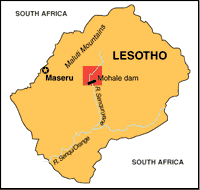 |
move cursor
over image
for local map |
Lesotho is the only country in the world
with all its territory above 1000 metres. Entirely surrounded by
South Africa, it is situated at the highest point of the Drakensberg
escarpment on the eastern rim of the South African plateau. Lesotho
is also one of the world's poorest nations: cultivable land is scarce,
mineral resources limited, and the country's most precious resource
is water. Indeed, the mountains in Lesotho form Southern Africa's
most important watershed - which is why one of the world's largest
and most complex engineering projects is taking place in one of
its most impoverished regions. The billion-dollar Lesotho Highlands
Water Project (LHWP) involves the construction of a series of tunnels
and dams to take water from Lesotho's Senqu/Orange River to South
Africa's industrial heartland, Gauteng province. In return, Lesotho
receives royalties from the sale of its water, and some hydroelectric
power.
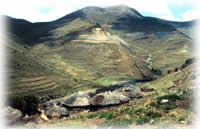 These
testimonies were gathered from several villages in the Molika-liko
area (see map). All the narrators have now been relocated, but in
their interviews they describe mountain life as they experienced
it then. Agriculture and livestock formed the mainstay of their
existence, but until recently most of the men spent significant
periods of time as migrant labour in the South African mines. This
was virtually the only option available to anyone wanting to earn
cash. Several months after the last interview was gathered, the
villagers were moved away from their mountain valley. The area is
to disappear under the waters of the huge Mohale reservoir, together
with their houses, fields, graveyards, grazing land and other private
and communal resources. These
testimonies were gathered from several villages in the Molika-liko
area (see map). All the narrators have now been relocated, but in
their interviews they describe mountain life as they experienced
it then. Agriculture and livestock formed the mainstay of their
existence, but until recently most of the men spent significant
periods of time as migrant labour in the South African mines. This
was virtually the only option available to anyone wanting to earn
cash. Several months after the last interview was gathered, the
villagers were moved away from their mountain valley. The area is
to disappear under the waters of the huge Mohale reservoir, together
with their houses, fields, graveyards, grazing land and other private
and communal resources.
the themes
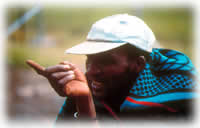 The
narrators describe a way of life that for generations has altered
relatively little. The most significant forces for change in recent
times have been increasing exposure to the monetary economy, and
the advent of the road, precursor to relocation and built as part
of the massive Lesotho Highlands Water Project. Agriculture, which
allowed a reasonable degree of self-sufficiency, is a dominant theme,
as are social institutions and the networks of mutual help and support
that the community has relied on and takes pride in. In the face
of imminent resettlement - some to lowlands and semi-urban areas;
some to other highland communities - people talk of their feelings
of powerlessness and vulnerability, their distrust of the Lesotho
Highlands Development Authority (LHDA) - the body responsible for
implementing resettlement - and their fears for the future. The
knowledge that their way of life was to change for ever may have
led some narrators to romanticise their current existence, but others
acknowledge tensions and dissension within and between communities.
Some narrators, too, talk of how social relations and attitudes
were already undergoing change, and not always just along generational
lines. The
narrators describe a way of life that for generations has altered
relatively little. The most significant forces for change in recent
times have been increasing exposure to the monetary economy, and
the advent of the road, precursor to relocation and built as part
of the massive Lesotho Highlands Water Project. Agriculture, which
allowed a reasonable degree of self-sufficiency, is a dominant theme,
as are social institutions and the networks of mutual help and support
that the community has relied on and takes pride in. In the face
of imminent resettlement - some to lowlands and semi-urban areas;
some to other highland communities - people talk of their feelings
of powerlessness and vulnerability, their distrust of the Lesotho
Highlands Development Authority (LHDA) - the body responsible for
implementing resettlement - and their fears for the future. The
knowledge that their way of life was to change for ever may have
led some narrators to romanticise their current existence, but others
acknowledge tensions and dissension within and between communities.
Some narrators, too, talk of how social relations and attitudes
were already undergoing change, and not always just along generational
lines.
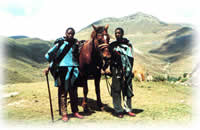 Not
surprisingly, however, the most common cause of anxiety in these
accounts is loss of self-sufficiency. Many express foreboding as
to how losing their land will affect them not just in terms of livelihood,
but also self-esteem. Most of the men's experience of working in
the South African mines has made them wary of the dependence generated
by being a wage labourer, and of the finite nature of money. Mountain
life might be frugal but with land, they felt, they always had a
productive resource - and a crucial degree of self-reliance. They
speak with pride of their environmental knowledge and how it has
enabled them to adapt and survive in a harsh landscape. But they
also know that it is precisely the specialist nature of their knowledge
- living in an area where each valley is distinguished by variations
of climate, soil and vegetation - which may render them at a loss
when they move elsewhere in the highlands. And for those moving
to urban areas, such skills are all but redundant. Not
surprisingly, however, the most common cause of anxiety in these
accounts is loss of self-sufficiency. Many express foreboding as
to how losing their land will affect them not just in terms of livelihood,
but also self-esteem. Most of the men's experience of working in
the South African mines has made them wary of the dependence generated
by being a wage labourer, and of the finite nature of money. Mountain
life might be frugal but with land, they felt, they always had a
productive resource - and a crucial degree of self-reliance. They
speak with pride of their environmental knowledge and how it has
enabled them to adapt and survive in a harsh landscape. But they
also know that it is precisely the specialist nature of their knowledge
- living in an area where each valley is distinguished by variations
of climate, soil and vegetation - which may render them at a loss
when they move elsewhere in the highlands. And for those moving
to urban areas, such skills are all but redundant.
the partners
The interviews were gathered between November 1997 and February
1998, with the help of local NGOs the Transformation Resource Centre (TRC) and Lesotho Highlands Church Action Group. The project was
coordinated by Dr Motlatsi Thabane, of the Department of History,
National University of Lesotho.
All narrators received illustrated copies of their interviews in Sesotho and English. In 2001 and 2002 TRC, with Panos, continued to gather interviews with the villagers, in order to gain greater understanding of their experiences in their new locations, several years after resettlement. In 2004 The Irony of the “White Gold” was published in Sesotho and English, based on these first-hand accounts. The booklet was part of a programme of activities that have raised awareness of the varied experiences of those affected by the LHWP, empowered them to lobby for their rights and, with TRC, gain some reforms to LHDA’s policies.
publications
|
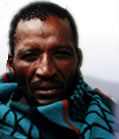
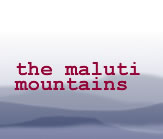


 These
testimonies were gathered from several villages in the Molika-liko
area (see map). All the narrators have now been relocated, but in
their interviews they describe mountain life as they experienced
it then. Agriculture and livestock formed the mainstay of their
existence, but until recently most of the men spent significant
periods of time as migrant labour in the South African mines. This
was virtually the only option available to anyone wanting to earn
cash. Several months after the last interview was gathered, the
villagers were moved away from their mountain valley. The area is
to disappear under the waters of the huge Mohale reservoir, together
with their houses, fields, graveyards, grazing land and other private
and communal resources.
These
testimonies were gathered from several villages in the Molika-liko
area (see map). All the narrators have now been relocated, but in
their interviews they describe mountain life as they experienced
it then. Agriculture and livestock formed the mainstay of their
existence, but until recently most of the men spent significant
periods of time as migrant labour in the South African mines. This
was virtually the only option available to anyone wanting to earn
cash. Several months after the last interview was gathered, the
villagers were moved away from their mountain valley. The area is
to disappear under the waters of the huge Mohale reservoir, together
with their houses, fields, graveyards, grazing land and other private
and communal resources.  The
narrators describe a way of life that for generations has altered
relatively little. The most significant forces for change in recent
times have been increasing exposure to the monetary economy, and
the advent of the road, precursor to relocation and built as part
of the massive Lesotho Highlands Water Project. Agriculture, which
allowed a reasonable degree of self-sufficiency, is a dominant theme,
as are social institutions and the networks of mutual help and support
that the community has relied on and takes pride in. In the face
of imminent resettlement - some to lowlands and semi-urban areas;
some to other highland communities - people talk of their feelings
of powerlessness and vulnerability, their distrust of the Lesotho
Highlands Development Authority (LHDA) - the body responsible for
implementing resettlement - and their fears for the future. The
knowledge that their way of life was to change for ever may have
led some narrators to romanticise their current existence, but others
acknowledge tensions and dissension within and between communities.
Some narrators, too, talk of how social relations and attitudes
were already undergoing change, and not always just along generational
lines.
The
narrators describe a way of life that for generations has altered
relatively little. The most significant forces for change in recent
times have been increasing exposure to the monetary economy, and
the advent of the road, precursor to relocation and built as part
of the massive Lesotho Highlands Water Project. Agriculture, which
allowed a reasonable degree of self-sufficiency, is a dominant theme,
as are social institutions and the networks of mutual help and support
that the community has relied on and takes pride in. In the face
of imminent resettlement - some to lowlands and semi-urban areas;
some to other highland communities - people talk of their feelings
of powerlessness and vulnerability, their distrust of the Lesotho
Highlands Development Authority (LHDA) - the body responsible for
implementing resettlement - and their fears for the future. The
knowledge that their way of life was to change for ever may have
led some narrators to romanticise their current existence, but others
acknowledge tensions and dissension within and between communities.
Some narrators, too, talk of how social relations and attitudes
were already undergoing change, and not always just along generational
lines.  Not
surprisingly, however, the most common cause of anxiety in these
accounts is loss of self-sufficiency. Many express foreboding as
to how losing their land will affect them not just in terms of livelihood,
but also self-esteem. Most of the men's experience of working in
the South African mines has made them wary of the dependence generated
by being a wage labourer, and of the finite nature of money. Mountain
life might be frugal but with land, they felt, they always had a
productive resource - and a crucial degree of self-reliance. They
speak with pride of their environmental knowledge and how it has
enabled them to adapt and survive in a harsh landscape. But they
also know that it is precisely the specialist nature of their knowledge
- living in an area where each valley is distinguished by variations
of climate, soil and vegetation - which may render them at a loss
when they move elsewhere in the highlands. And for those moving
to urban areas, such skills are all but redundant.
Not
surprisingly, however, the most common cause of anxiety in these
accounts is loss of self-sufficiency. Many express foreboding as
to how losing their land will affect them not just in terms of livelihood,
but also self-esteem. Most of the men's experience of working in
the South African mines has made them wary of the dependence generated
by being a wage labourer, and of the finite nature of money. Mountain
life might be frugal but with land, they felt, they always had a
productive resource - and a crucial degree of self-reliance. They
speak with pride of their environmental knowledge and how it has
enabled them to adapt and survive in a harsh landscape. But they
also know that it is precisely the specialist nature of their knowledge
- living in an area where each valley is distinguished by variations
of climate, soil and vegetation - which may render them at a loss
when they move elsewhere in the highlands. And for those moving
to urban areas, such skills are all but redundant.
